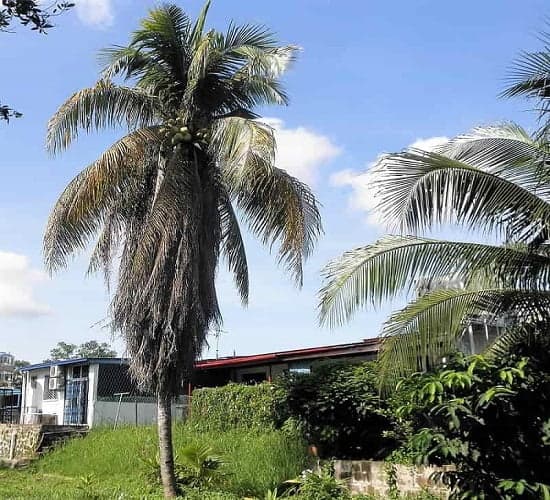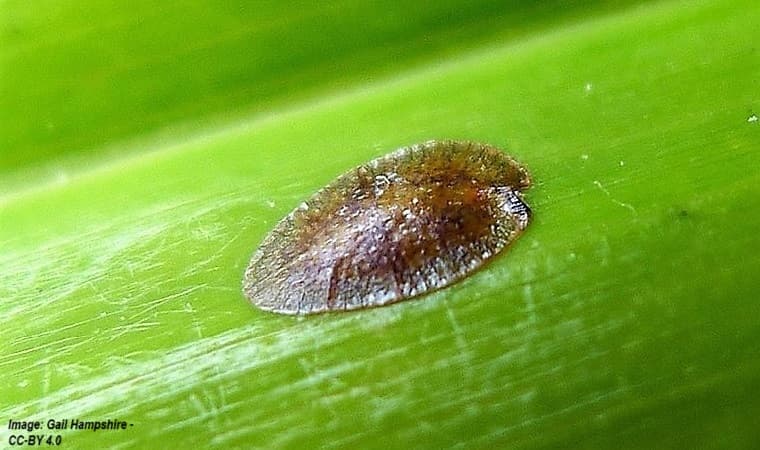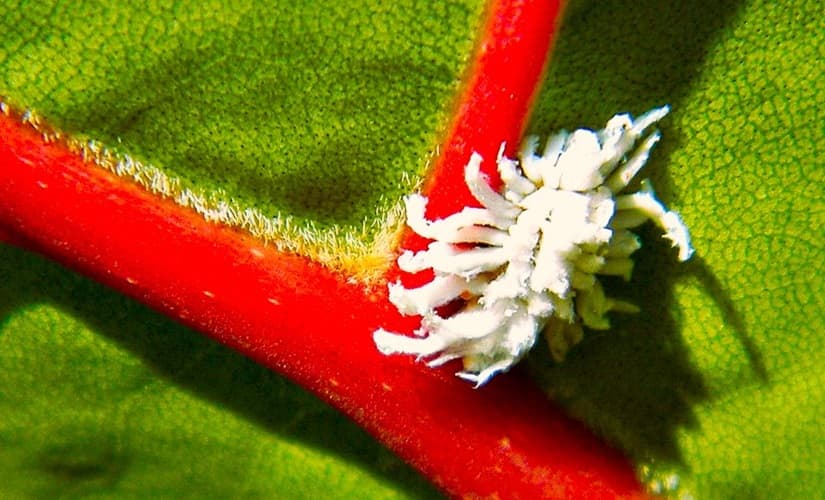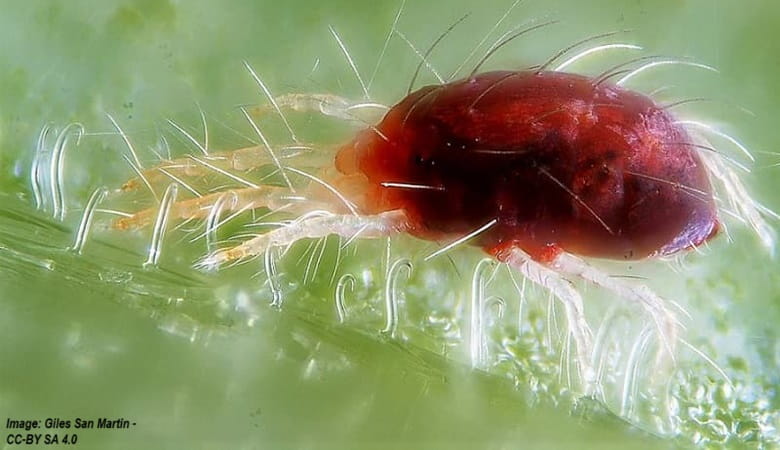- Home
- Palm Problems
Palm Tree Problems - Disease Explanations & Tips
Palm tree problems are something to be aware of, even though many palms require easy care.
If you're noticing a problem, you'd want to solve it as early as possible. It's not fun worrying that you have an infected tree! Especially after investing money in purchases of healthy palms.
Species of palms face palm disease attacks, tiny Insect problems, lack of nutrients & more. Move along through our page to learn. Or Click Below to Check for your concern...
Feeling overwhelmed by so many palm trees?
You're not alone. We Understand your headaches! At Mission: Palm Trees you'll find clear answers to questions & Step-By-Step Guidance, from real people. With solutions to help. No puzzling shoptalk. No tiring research. So it's easy & fun for you.
Symptom Diagnosis For Common Palm Tree Problems
Using visible symptoms to diagnose palm tree problems you see is not always reliable. Multiple possibilities cause similar symptoms. Yet it's the quickest, cheapest way to try figuring out a common problem.
Look at the first symptom. See which palm species typically have that problem. Getting help from Palm Books is quite helpful.
FTC Disclosure: If you purchase via a link/ ad on this site, we may earn a small royalty. There's no added cost to you. Thanks much for any looks/ orders! Details>
One we like & continually use is Ornamental Palm Horticulture.
- Very useful for learning so much about palm tree problems & more.
- With lots of good photographs for added assistance, helping see signs of disease & give proper care.
Pro Help for Species of Palm Trees with Problems?
You may end up needing professional help for your diseased tree. Meanwhile, first try our hints to get you started:
HOW WILTING PALM FROND SYMPTOMS ARE SIGNS OF PROBLEMS
- Possible problems: watering too much OR too little, root rot or nutrient deficiencies.
SEEING DISEASE SYMPTOMS & SIGNS OF FRONDS WITH BROWN SPOTS?
- Potential sign for fungal disease, nutrient deficiencies, or pest attack.
- Evaluate Palm Tree Care for Brown Leaves! It may be from Cold Damage or palm disease.
LEAF YELLOWING MEANS COMMON NUTRITION LACKING OR DISEASE
- Yellowing is called chlorosis. Common Symptom for Many Palm Species.
- Could be Problems With Nutrients, overwatering, or tiny insect problems.
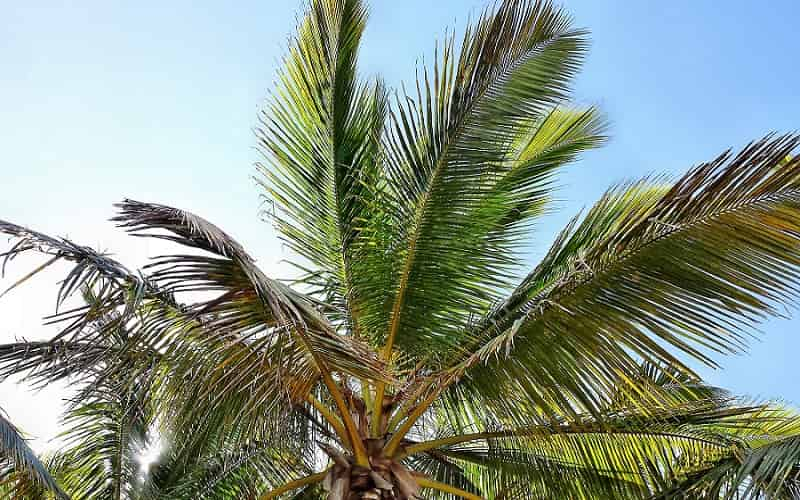 Browning Frond Leaflets Indicate Problems
Browning Frond Leaflets Indicate Problems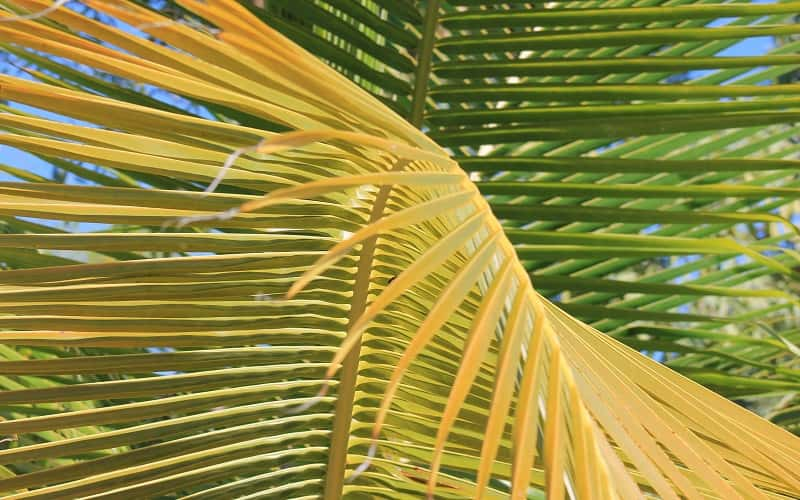 Chlorosis is leaf yellowing, as seen in this Palm Frond.
Chlorosis is leaf yellowing, as seen in this Palm Frond.TRUNK STEM PROBLEMS WITH NEW CRACK OR HOLE SYMPTOMS
- Cracks can happen in old age, or with wind damage.
- But tiny insect species can do this damage. Scale & Borers drill holes.
NEW SAGGING FRONDS? COMMON SIGNS & SYMPTOMS
- Some lower fronds naturally limp downward.
- Is it a change? See if there's too little or too much water, or a serious nutritional need.
DYING PALM TREE LEAVES MAY MEAN PESTS OR DISEASE PROBLEMS
- Or maybe not! Naturally happens with oldest leaves in most palm tree species.
- But dead leaves do happen with frost, over/under watering, or from bug infestations.
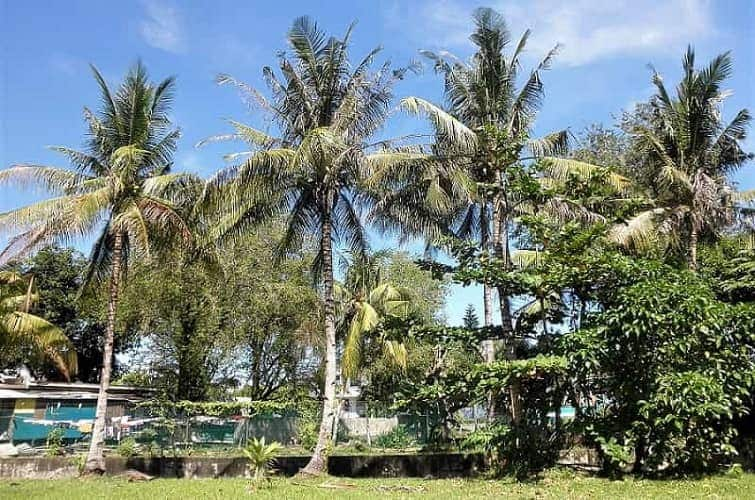 What is Making These Coconut Palms Sick? Photo: Jason Thien @Flickr - CC BY 4.0
What is Making These Coconut Palms Sick? Photo: Jason Thien @Flickr - CC BY 4.0Common Palm Tree Pests & Palm Disease Problems
Nothing throws a skip into your palmy heart like finding that first symptom on your palm tree. Teeny bugs crawling around, or leaf spots with different coloring. Or something oozing out from a palm trunk. Reminding you of some horror end-of-the-world film!
Let's see the wide range of diseases & insect attacks that are common palm tree problems.
Common Tiny Insect Palm Tree Pests Signs & Symptoms
These pests damage palms in various ways.
- They chew into fronds.
- They feed on palm sap.
- And Tunnel into essential Palm Parts.
- They carry palm disease that causes bacterial infection.
How Tiny Insect Pests Harm the Health of Palm Trees
Two Scientific classes attack palms. As arthropods, Insecta & Acari have exoskeletons made of chitin.
- Scales: Tiny squooshy bugs that cover themselves in dull color disguises. Three scale insect species harm palm species by sucking out sap juices.
- One attacks landscape palms: Eucalymnatus tessellatus. The main problem is leaving behind honeydew waste secretions.
- Mealybugs - Very small, with oblong shape. And a white waxy covering with wax projections all over. Usually found hidden near leaf bases & other unnoticeable spots. They choose a feeding place & stay for life.
- Problematic is sooty mold growth encouraged by mealybugs' abundant honeydew excrement.
- A natural predator is the Mealybug Destroyer, a ladybird beetle.
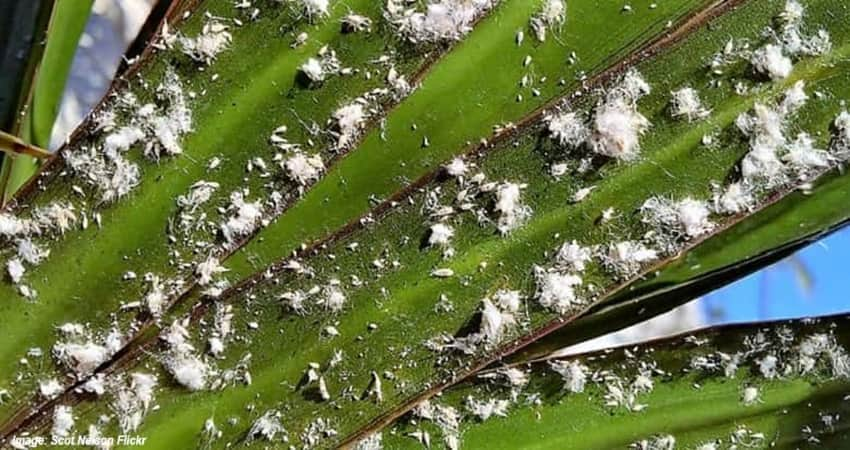 Infestation of Mealybugs
Infestation of Mealybugs- Weevils - Small snout beetles. Along with other palm weevils, often the prime targets are stressed palms. Their harmful stage is larval, drilling holes, tunneling throughout the lower trunk.
- The Red Palm Weevil or Palmetto Weevil is native to Florida. They can be solid black to almost all red, with patterns. In recent years it's become more widespread. Attacking Canary Island Date Palms (Phoenix canariensis), Bismarck (Bismarckia nobilis) & Latania species of palms. AKA Palmetto Weevil. As
- One species carries nematodes that cause red ring disease. Attacking Date & Royal Palms, but primarily Coconut & Oil Palms. It's a deadly disease.
- The red ring is internal. Outer signs are misshapen fronds yellowing then turning reddish-brown. Then wilting & dying.
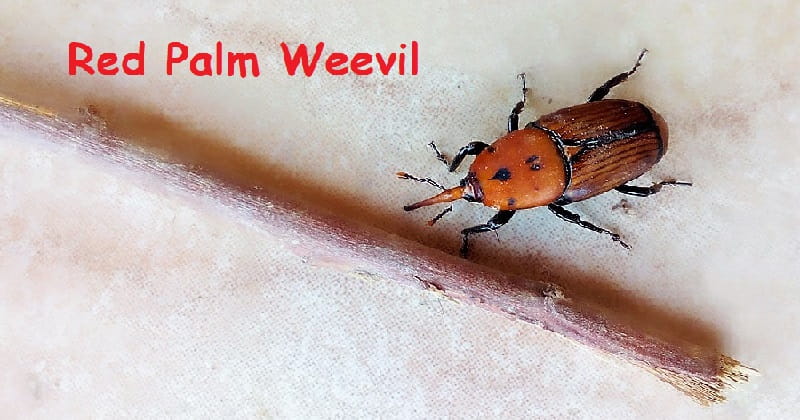 AKA Palmetto Weevil. As their coloring can be solid black to almost all red. With patterns.
AKA Palmetto Weevil. As their coloring can be solid black to almost all red. With patterns.- Nematodes - Wormy looking parasites, in the scientific Phylum Nematoda. Most commonly carried by Palm Weevils, especially Rhynchophorus palmarum.
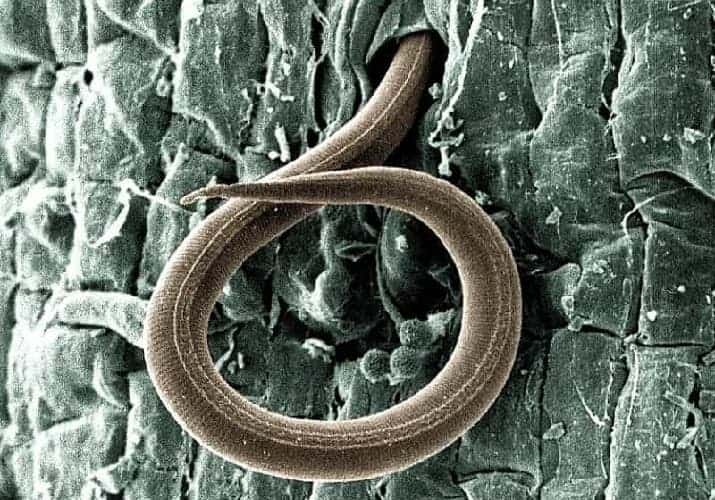 Root Knot Nematode Enters a Plant's Root - Creepy, eh??
Root Knot Nematode Enters a Plant's Root - Creepy, eh??USDA - Photo: William Wergin from Richard Sayre - CC BY 4.0
- Thrips - Teeniest narrow winged pest. Nymphs & adults do the damage. Roughing up frond undersides to feed on cell innards.
- Symptomatic fronds look silver, with tiny scatted black spots.
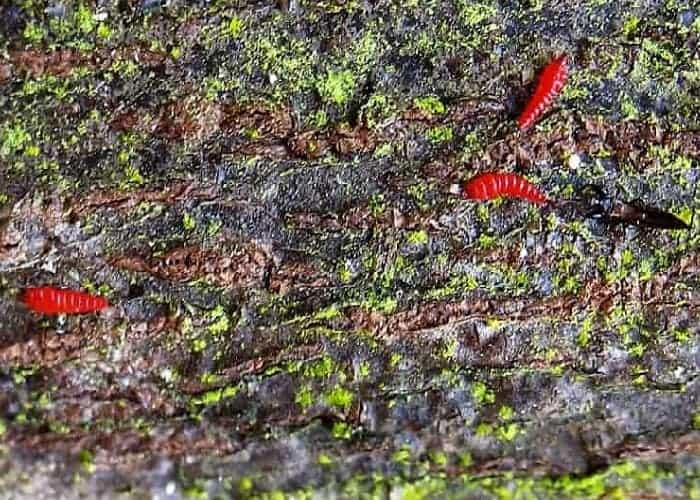 Thrips: Ecacanthothrips tibialis. Feeding on Fungi of Dead & Dying Plant Matter
Thrips: Ecacanthothrips tibialis. Feeding on Fungi of Dead & Dying Plant Matter- Spider Mites - Another tiny insect that sucks out palm sap. White webbing hints that they're attacking. Injured fronds have scattered spots. Primarily a problem for Potted Palm Plants. Inspect indoor palms regularly & prevent with regular Rinsing With a Syringe.
Common Palm Tree Disease Problems - Signs & Symptoms
Palm Tree Landscape Problems With Freezing Weather
With Hard Freezes, there's the danger of bacteria or fungal disease attacking the weakened apical meristem. Commonly, Lethal Bud Rot. Use copper fungicides asap, then again in a week.
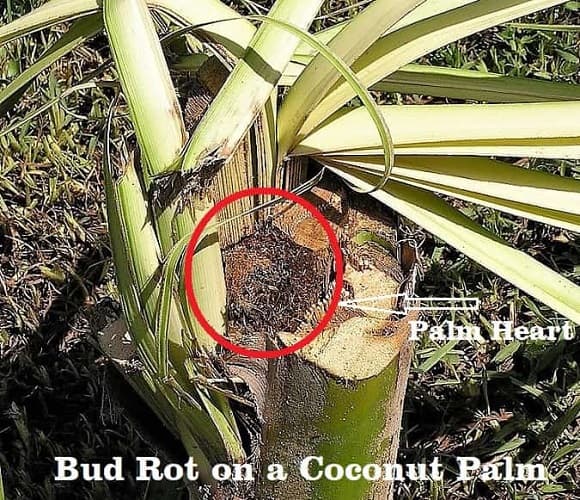 When the Palm Bud Dies, the Palm Tree Dies!
When the Palm Bud Dies, the Palm Tree Dies!Different Types Of Fungal Disease Palm Tree Problems
Multiple species can be affected by a fungal illness. Palm Tree Fungus Spray is a treatment.
- Root & Pink Rot - Fungal disease attacks numerous Palm Tree Parts. Often Container Palms without good drainage and/or from Overwatering Palms. Tons of pink fungal spores are symptoms. Causing discoloring.
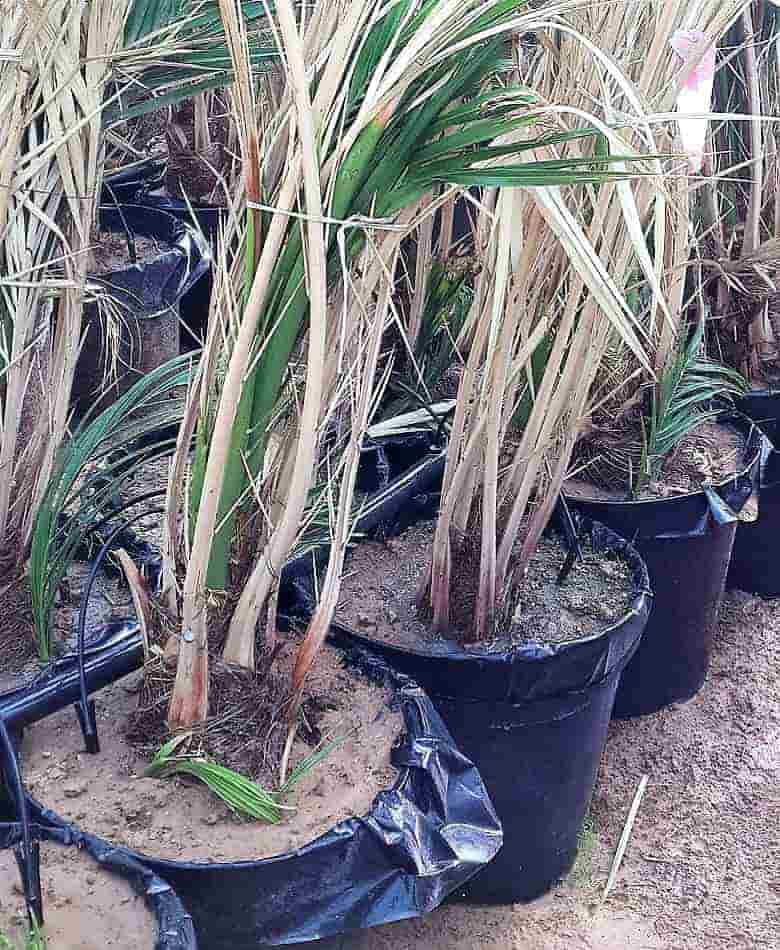 Young Palms in Pots Lined With Plastic Sheeting
Young Palms in Pots Lined With Plastic SheetingAllowing No Soil Drainage, Giving Rise to Rot Fungus
- Trunk Rot - Two pathogen species cause fatal disease in landscape palms. Fungal spores can contaminate nearby palms. An infected tree becomes a hazard & needs removal.
- The fungus Ganoderma zonatum causes Ganoderma Butt Rot. Typically in the Southeastern U.S.
- Oldest leaves dying early is a first symptom. Along with white bumps (conks) on the trunk bottom. They enlarge & turn brownish. Brown tips on fronds throughout the infected tree, wilting follows.
- "Guts" in the lower trunk degrade, leading to the palm falling over.
- Thielaviopsis paradoxa attacks mature palms worldwide. Fungal spores invade from a wound or cut in the upper palm trunk (think unnecessary pruning!).
- Inner tissues spoil, causing trunk weakness. Meanwhile fronds die progressively, beginning with leaf tips.
- Sometimes, brown ooze leakage is seen. Eventually the palm bends at the upper trunk, under the crown. Then breaks off.
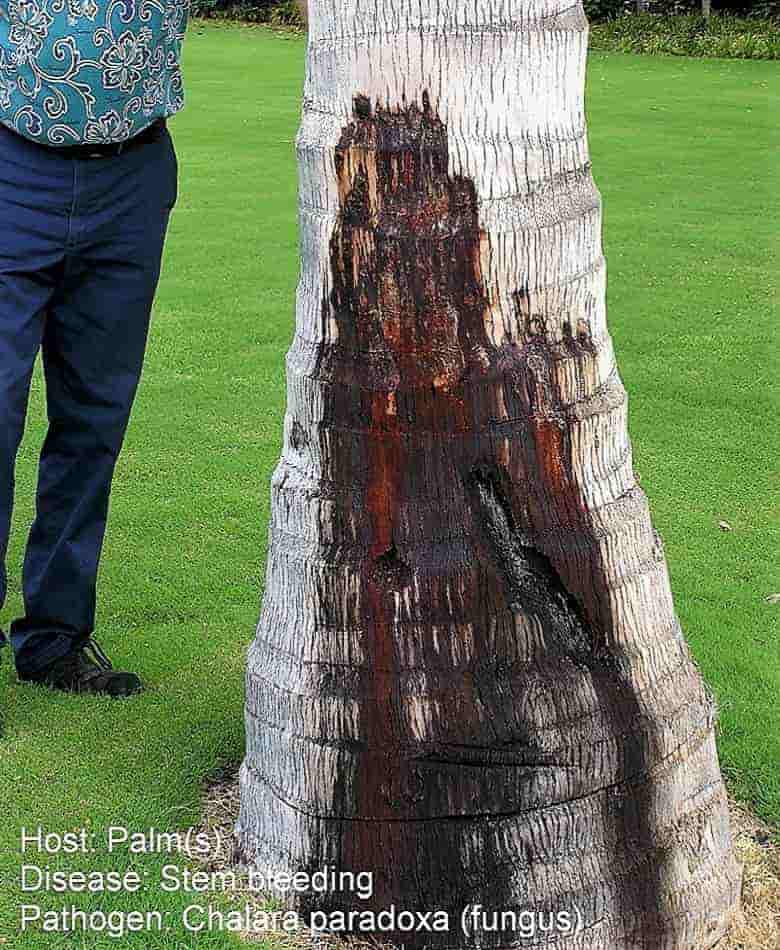
Other Common Diseases That Are Palm Tree Problems
- Leaf Spots - Multiple species cause these palm tree problems. Watch for yellow (chlorotic) areas. Then turning brown & developing a dark ring around the edge.
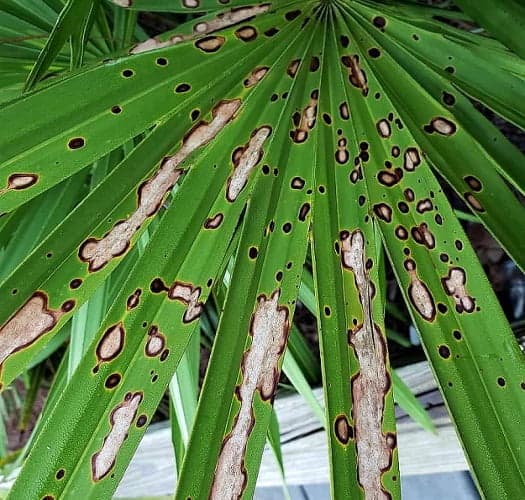 Leaf Spot Fungus - Possibly Caused by a Bipolaris Species
Leaf Spot Fungus - Possibly Caused by a Bipolaris Species- Blights - Affect Specific Parts of Fronds, especially the rachis or petiole. Normally not deadly, but doesn't look very nice! Because blight turns leaflets, segments & stems brownish.
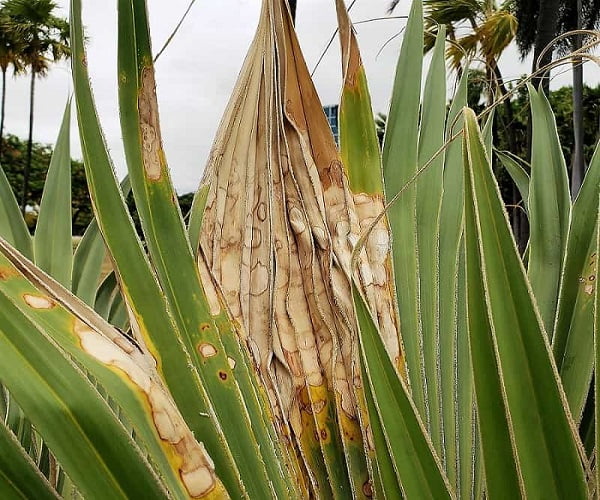 Fan Palm With Leaf Blight From the Pathogen Bipolaris incurvata
Fan Palm With Leaf Blight From the Pathogen Bipolaris incurvata- Fusarium Wilt - Block water flow within a palm. A fatal disease, as you can imagine. Primarily attacking the Queen Palm, Mexican Fan Palm & also Canary Island Date Palms.
- Usually begins with lower leaves. Turning yellow (chlorotic) & dying.
- It moves upward, gradually killing all fronds.
- Distinctively on feather fronds, because it begins on one side of the stem (rachis).
- Phytoplasma Disease - Problematic bacteria. Carried mostly by Hemiptera insects: leafhoppers, planthoppers or psyllids.
- Primarily causes Phytophthora Bud Rot. The spear & new growth fronds affected first. With wilting & discoloration. Affects about 30 species, but especially Coconut Palms.
- In the Southeastern US & Caribbean causes Lethal Bronzing Disease. First symptom is early drop of the fruiting body, or flower stalk rotting. Preventative antibiotics may obstruct spread to healthy palms.
Nutritional Palm Tree Problems That Harm Your Plant
When growing palms recognizing nutritional problems is important. But better to have needed information to prevent these problems!
For instance, lack of the right nitrogen percentage in fertilizer can cause yellowing leaves or excessive growth. A lack of potassium can cause leaf tips to die.
Also deficiencies in magnesium & manganese can lead to palm fronds losing their green color. Often turning yellow (chlorosis).
The essential basic is knowing your palm soil's pH. With alkaline soils, needed elements won't be absorbed. That's why A Soil Test is the starting point.
What You Need to Know About Palm Nutrition>
Common Physiological Palm Tree Problems
These are assorted circumstances that can harm palms. Those that aren't living organisms like germs, fungi, attacking bugs, etc.
These issues can sometimes be prevented or helped with Advance Planning for Planting Palms.
For Instance How Overwatering Palms is a No-No!
Overwatering causes water-logged soil. Palms definitely don't want soggy "feet."
- From misjudging a palm's water needs.
- Letting the sprinkler system go on schedule, no matter how much rain there's been.
- Planting the palm where the drainage is poor.
- Watering a Desert Palm Tree too much.
 Not Good - Palm Overwhelmed by Water!
Not Good - Palm Overwhelmed by Water!Symptoms of physiological problems can be confusing. Because they're the same as many diseases. Some Palm Tree Habitat Problems may be solved, because you can change the causing situations.
Many more physiological Palm Problems Need Your Help, because it involves action.
Plant Difference: Are These Palm Tree Problems?
Have you heard rumors about palms causing some problems? Maybe they're toxic to animals, or even people! Or there's odd growth on palms. Is that normal?
Check on More Details to Curb Your Worries & solve these issues!
Painted Palm Tree Trunks in the Landscape
Have you been to places where they Paint Palm a Tree Trunk White? But only on the bottom. Many wonder why that's done & if it's necessary. Or is something problematic with these painted palms?
Farming history typically began this process, with fruit trees. And the idea spread!
Are Strange New Palm Tree Roots Signs of a Problem?
Some palms suddenly start to show their roots above the ground. Particularly if you've had it a long time. If you thought that was a palm root problem, don't worry! This Should Help>
Two Common Palm Trees With Problems
Some palms seem to attract questions about problems more than others. Two species of palms immediately come to mind.
Queen Palm Trees With Problems That Worry People
Syagrus romanzoffiana has some concerns.
They're grown in many Southern California & Florida cities. Some people are allergic to its flower pollen.
- It's fussy For Having Nutrients. Especially needs its quote of manganese!
- Fruit dropping is quite messy.
- Roots are kind-of weakly entrenched in the ground. With storms, it's in danger of blowing over.
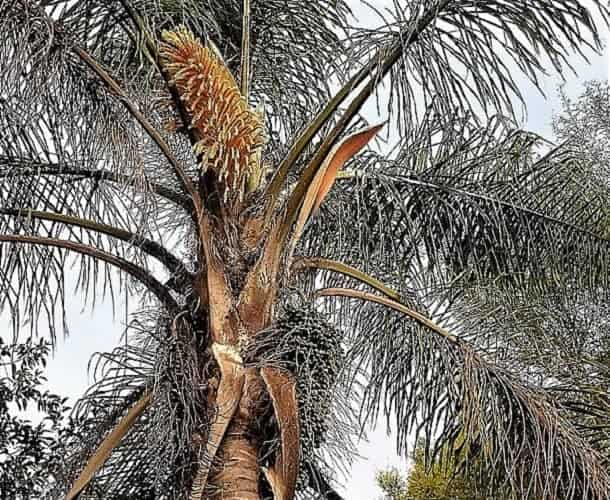 Syagrus romanzoffiana is commonly called the Queen Palm.
Syagrus romanzoffiana is commonly called the Queen Palm.This One is in Moreleta Park, Pretoria, South Africa
Photo: JMK -CC BY-SA 4.0
Sylvester Palm Trees common annoying Problems
Phoenix sylvestris is a nice durable palm.
So what could be wrong? False smut symptoms can occur. Teeny, tiny black, brown or yellow spots on frond surfaces. That become leaf indentations.
- Yes, False Smut Disease is possible! Yikes, what is that? A kind of fungus most often harming Phoenix palms in humid areas. Yet not usually deadly - just doesn't look pretty.
- There's skimpy management & containment research. Trying Fungicide is fine. Follow product directions. Catch it early, then treat by trimming off affected fronds.
- Beware of spiny spikes on the leaflets!
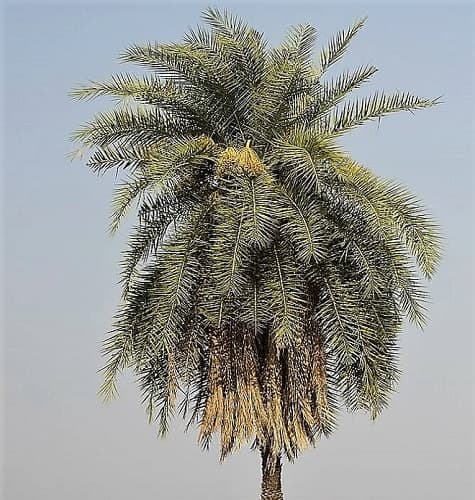 Phoenix sylvestri
Phoenix sylvestri Other Common Names: Toddy Palm & Wild Date Palmp.
Photo: P.Jeganathan - CC BY-SA 4.0
Takeaways for palm tree problems
Having palm trees in your landscaping surrounds your home with calm beauty. But palm tree problems can arise.
Learning something about the palm plant diseases & pests that could affect your palm trees is wise. Good preparation for their care. So you're proactive with keeping your palms thriving all year round.
We hope we gave you some guidance to get you started on the most common palm tree problems. And being prepared with preventative tips for disease spread & solutions.
